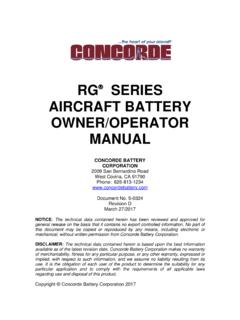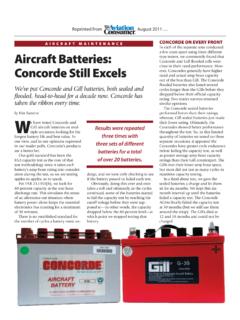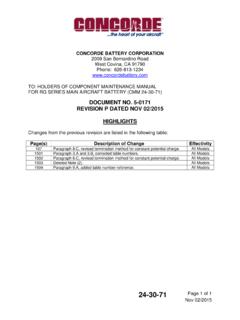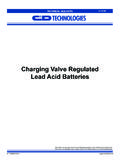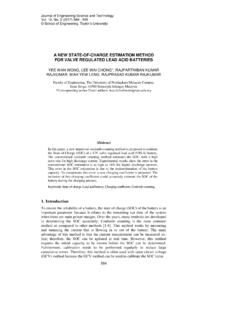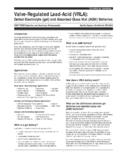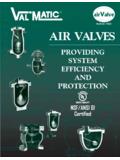Transcription of CONCORDE BATTERY 1 VALVE REGULATED LEAD ACID …
1 Hazard Rating F. CONCORDE BATTERY . VALVE REGULATED 1. H 3 R. LEAD ACID BATTERY 2. ACID. SAFETY DATA SHEET. SECTION 1 chemical product AND company identification . product Name: VALVE REGULATED Sealed Non-Spillable Lead Acid BATTERY product USE: Electric Storage BATTERY MANUFACTURER'S NAME: CONCORDE BATTERY CORPORATION EMERGENCY CONTACT.: CHEMTEL (800) 255-3924. ADDRESS: 2009 San Bernardino Rd., West Covina, CA 91790 OTHER INFORMATION CALLS: (626) 813-1234. COMMON NAME: (Used on label) VALVE REGULATED Sealed Non-Spillable Lead-Acid BATTERY Revised Date: August 08, 2018. (Trade Name & Synonyms) VRB, VRLA, SLAB, Recombinant Lead Acid: RG, D8565 Series SECTION 2 - HAZARD identification . GHS Classification: Health Environmental Physical Acute Toxicity Category 4 Aquatic Chronic 1 Explosive chemical , Division (Oral/Dermal/Inhalation) Aquatic Acute 1.
2 Skin Corrosion/Irritation Category 1A. Eye Damage Category 1. Reproductive Category 1A. Carcinogenicity (lead) Category 1B. Carcinogenicity (acid mist) Category 1B. Specific Target Organ Toxicity (repeated exp.) Category 2. GHS Label: Health Environmental Physical Hazard Statements Precautionary Statements DANGER! Wash thoroughly after handling. Normal Operating Conditions Do not eat drink or smoke when using this product . May damage fertility or the unborn child if ingested or inhaled. Wear protective gloves/protective clothing, eye protection/face protection. May cause cancer if ingested or inhaled. Avoid breathing dust/fume/gas/mist/vapors /spray. Causes damage to central nervous system, blood and kidneys Use only outdoors or in a well-ventilated area. through prolonged or repeated exposure. Causes skin irritation, serious eye damage.
3 Contact with internal components may cause irritation or severe burns. Abnormal Conditions (Broken Case or Extreme Overcharging). Avoid contact with internal acid. Causes severe skin burns and eye damage. Causes serious eye Irritating to eyes, respiratory system, and skin. damage. May form explosive air/gas mixture during charging. Extremely flammable gas (hydrogen). Explosive, fire, blast or projection hazard. WARNING: BATTERY posts, terminals and related accessories can expose you to chemicals including lead and lead compounds, which are known to the State of California to cause cancer and birth defects or other reproductive harm. Wash hands after handling. For more information go to SECTION 3 COMPOSITION/INFORMATION ON INGREDIENTS. PRINCIPAL HAZARDOUS. COMPONENT(S) Hazard Category % Weight ACGIH OSHA. ( chemical & common name(s) TLV PEL/TWA.)
4 7439-92-1 Lead Acute-Chronic 40-50 mg/m3 mg/m3. 1309-60-0 Lead Dioxide Acute-Chronic 15-25 mg/m3 mg/m3. 12036-76-9 Lead Oxide Sulfate Acute-Chronic 5-15 mg/m3 mg/m3. 1317-36-8 Lead Monoxide Acute-Chronic <5% mg/m3 mg/m3. 12065-90-6 Pentalead Tetraoxide Sulfate Acute-Chronic <1% mg/m3 mg/m3. 12202-17-4 Tetralead Trioxide Sulfate Acute-Chronic <1% mg/m3 mg/m3. 7440-70-2 Calcium Reactive < Not Established Not Established 7440-31-5 Tin Chronic <1 2 2. Reactive-Oxidizer 7664-93-9 Sulfuric Acid ( BATTERY Electrolyte) 10-15 Acute -Chronic Note: PEL's for Individual states may differ from OSHA's PEL's. Check with local authorities for the applicable state PEL's. OSHA Occupational Safety and Health Administration; ACGIH American Conference of Governmental Industrial Hygienists; NIOSH National Institute for Occupational Safety and Health.
5 SECTION 4 - FIRST AID MEASURES. Emergency and First Aid Contact with internal components if BATTERY is opened/broken. Procedures Sulfuric Acid: Remove to fresh air and provide medical oxygen/CPR if needed. Obtain medical attention. Inhalation Lead: Remove from exposure, gargle, wash nose and lips; obtain medical attention. Sulfuric Acid: Do not induce vomiting. If conscious drink large amounts of water. Obtain medical attention. Never give anything by mouth to an Ingestion unconscious person. Lead: Consult physician immediately. Sulfuric Acid: Flush contacted area with large amounts of water for at least 15 minutes. Remove contaminated clothing and obtain medical attention if Skin necessary. Lead: Wash immediately with soap and water Eyes Sulfuric acid and/or lead: Immediately flush with large amounts of water, hold eyelids open.
6 Obtain medical attention. SECTION 5 - FIREFIGHTING MEASURES. Flash Point Not Flammable Limits in Air % by Volume: Extinguishing Media Class ABC, CO2, Halon. Do not use carbon Auto-Ignition 675 F (polypropylene). Applicable Not Applicable dioxide directly on cells. Avoid breathing vapors. Temperature Fire Fighting Lead/acid batteries do not burn, or burn with difficulty. Do not use water on fires where molten metal is present. Extinguish fire with agent suitable for Procedures surrounding combustible materials. Cool exterior of BATTERY if exposed to fire to prevent rupture. The acid mist and vapors generated by heat or fire are corrosive. Use NIOSH approved self-contained breathing apparatus (SCBA) and full protective equipment operated in positive-pressure mode. Hazardous Combustion During normal operations, small amounts of highly flammable hydrogen gas may be generated during charging and operation of batteries.
7 Avoid open Products flames/sparks/other sources of ignition near BATTERY . Unusual Fire and Sulfuric acid vapors are generated upon overcharge and polypropylene case failure. Use adequate ventilation. Avoid open flames/sparks/other sources of ignition Explosion Hazards near BATTERY . Carefully follow manufacturer's instructions for installation and service. Do not allow metallic articles to simultaneously contact the negative and positive terminals of a BATTERY , as a short circuit will cause high current flow; create high heat and the possibility of fire. Use adequate ventilation. SECTION 6 - ACCIDENTAL RELEASE MEASURES. Procedures for Cleanup: Avoid contact with any spilled material. Contain spill, isolate hazard area, and deny entry. Limit site access to emergency responders. Neutralize with sodium bicarbonate, soda ash, lime or other neutralizing agent.
8 Place BATTERY in suitable container for disposal. Dispose of contents/container in accordance with local/regional/national/international regulations. Sodium bicarbonate, soda ash, sand, lime or other neutralizing agent should be kept on-site for spill remediation. Personal Precautions: Acid resistant aprons, boots and protective clothing. ANSI approved safety glasses with side shields/face shield recommended. Environmental Precautions: Lead and its compounds and sulfuric acid can pose a severe threat to the environment. Contamination of water, soil and air should be prevented. SECTION 7 - HANDLING AND STORAGE. Precautions to be Taken Store away from reactive materials, open flames and sources of ignition as defined in Section 10 Stability and Reactivity Data. Store batteries in cool, dry, in Handling and Storage well-ventilated areas.
9 Batteries should be stored under roof for protection against adverse weather conditions. Avoid damage to containers. Do not allow the positive and negative terminals to contact each other, a short circuit will cause high current flow, creating high heat and the possibility of a fire. Precautions during charging Use proper voltages during charging (see BATTERY label). Never use a BATTERY that has less than 80% of rated capacity and never jump start an aircraft that has a dead or discharged BATTERY . Always remove a dead BATTERY from the aircraft and perform a capacity test to verify airworthiness. Charge at constant potential (constant voltage) only. For optimum life, BATTERY charge voltage should be adjusted with the BATTERY operating temperature. Other Precautions GOOD PERSONAL HYGIENE AND WORK PRACTICES ARE MANDATORY.
10 Refrain from eating, drinking or smoking in work areas. Thoroughly wash hands, face, neck and arms, before eating, drinking and smoking. Work clothes and equipment should remain in designated lead contaminated areas, and never taken home or laundered with personal clothing. Wash soiled clothing, work clothes and equipment before reuse. SECTION 8 - EXPOSURE CONTROLS AND PERSONAL PROTECTION. Respiratory Protection None required under normal conditions. Acid/gas NIOSH approved respirator is required when the PEL is exceeded or employee experiences respiratory irritation. Ventilation Store and handle in dry ventilated area. If mechanical ventilation is used, components must be acid-resistant. Skin Protection Wear rubber or plastic acid resistant gloves. Under severe exposure or emergency conditions, wear acid-resistant clothing, gloves, and boots.
